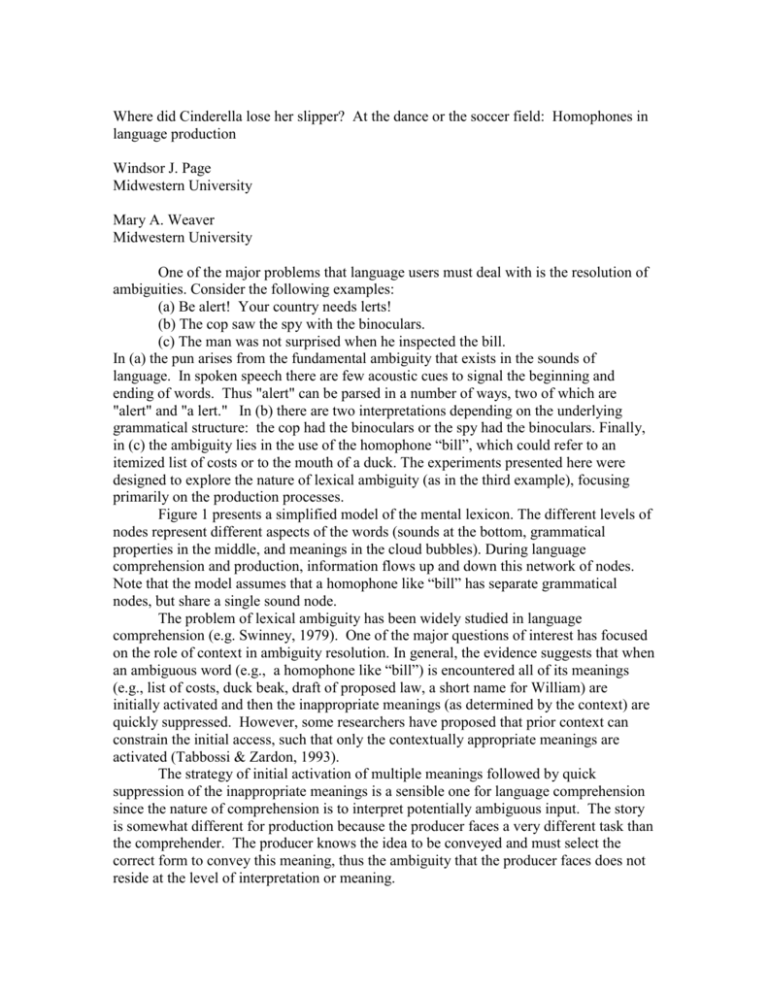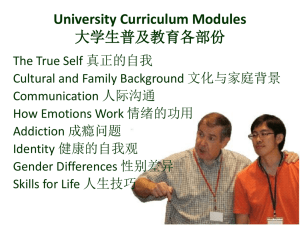Where did Cinderella lose her slipper
advertisement

Where did Cinderella lose her slipper? At the dance or the soccer field: Homophones in language production Windsor J. Page Midwestern University Mary A. Weaver Midwestern University One of the major problems that language users must deal with is the resolution of ambiguities. Consider the following examples: (a) Be alert! Your country needs lerts! (b) The cop saw the spy with the binoculars. (c) The man was not surprised when he inspected the bill. In (a) the pun arises from the fundamental ambiguity that exists in the sounds of language. In spoken speech there are few acoustic cues to signal the beginning and ending of words. Thus "alert" can be parsed in a number of ways, two of which are "alert" and "a lert." In (b) there are two interpretations depending on the underlying grammatical structure: the cop had the binoculars or the spy had the binoculars. Finally, in (c) the ambiguity lies in the use of the homophone “bill”, which could refer to an itemized list of costs or to the mouth of a duck. The experiments presented here were designed to explore the nature of lexical ambiguity (as in the third example), focusing primarily on the production processes. Figure 1 presents a simplified model of the mental lexicon. The different levels of nodes represent different aspects of the words (sounds at the bottom, grammatical properties in the middle, and meanings in the cloud bubbles). During language comprehension and production, information flows up and down this network of nodes. Note that the model assumes that a homophone like “bill” has separate grammatical nodes, but share a single sound node. The problem of lexical ambiguity has been widely studied in language comprehension (e.g. Swinney, 1979). One of the major questions of interest has focused on the role of context in ambiguity resolution. In general, the evidence suggests that when an ambiguous word (e.g., a homophone like “bill”) is encountered all of its meanings (e.g., list of costs, duck beak, draft of proposed law, a short name for William) are initially activated and then the inappropriate meanings (as determined by the context) are quickly suppressed. However, some researchers have proposed that prior context can constrain the initial access, such that only the contextually appropriate meanings are activated (Tabbossi & Zardon, 1993). The strategy of initial activation of multiple meanings followed by quick suppression of the inappropriate meanings is a sensible one for language comprehension since the nature of comprehension is to interpret potentially ambiguous input. The story is somewhat different for production because the producer faces a very different task than the comprehender. The producer knows the idea to be conveyed and must select the correct form to convey this meaning, thus the ambiguity that the producer faces does not reside at the level of interpretation or meaning. With respect to homophones, an initial activation of multiple meanings of a lexical item does not seem a useful strategy. Suppose that someone asked the question, "What is the beak of a duck called?" If the person answering the question selects the word bill to convey the idea of [the beak of a duck], it seems unlikely that he/she would also wish to activate the alternative meaning of bill (a list of fees). The fact that the lexical instantiation of the two meanings are phonologically identical should be irrelevant. A current debate in language production research focuses on how information flows through the nodes. In the top-down modular approach (Levelt, 1989), activation flow is one-way, from the meaning level down to the sound level. A model that assumes this approach predicts that the alternative inappropriate meanings of a homophone (e.g., money when the duck meaning of bill is intended) should not receive any activation during the course of production. Alternatively, interactive theories propose that (e.g. Dell, 1986, 1990) information flow through the network is bidirectional (i.e., activation flows down and up the connections). This allows feedback from lower levels, to influence activation levels at higher levels. Models of this sort predict the activation of the alternative meaning of a homophone through feedback from the shared sound node. The experiment presented here was designed to examine the issue of feedback in language production. We presented participants with simple questions during which an interfering word sometimes appeared on the screen. Their task was to answer the question as fast as they could after the offset of the question. For example, if the question was "At what event did Cinderella lose her slipper?", the participants were expected to answer “ball”. There were three types of interfering words: either a word related to the answer (“dance”), inappropriately related (“round”, as in a toy ball) or a word unrelated to both meanings (“tree”) to the answer of the question. The expectation was that the related words would exhibit an effect on the naming latencies to the questions relative to the unrelated words. The top-down modular view of production predicts that there should be no effect of the inappropriate interfering word. That is, the inappropriate condition should show the same pattern of results as the neutral condition. Additionally we manipulated the relative dominance of meaning for the homophones (e.g. the softball meaning of ball is more dominant than the dance meaning of ball). Method Participants Thirty-six Midwestern University students participated as part of a requirement in introductory psychology classes or for payment. All were native speakers of English. Materials and Design Twenty-four critical questions were created in such a way as to put much of the information near the end in an effort to prevent participants from coming up with the answer before the question's offset. In addition to the experimental items, we constructed and recorded forty-eight filler questions. These questions were designed to elicit simple one-word answers and were constructed to have a similar range of difficulty and level of informational content as the critical items. We constructed unrelated distracter words for twelve of these filler questions, so that the critical items would not be the only items with distracter words. Using these items we constructed three lists each containing seventy-two questions. Within each of these lists, we manipulated the relatedness of the distracter word for each question, such that on each list one-third of the critical questions had appropriately related distracter words, one third inappropriately related distracter words, and the remaining third had unrelated distracter words. Procedure Participants were run in individual sessions. An example of a single trial was as follows. The participant initiated each trial by pressing the space bar on a computer. Through headphones, participants were presented a simple question. After the offset of the question, a question mark appeared (just above the center of the screen so that it would not interfere with distracter word) prompting the participant to answer the question aloud as quickly as possible. If the participant responded before the presentation of the question mark, then the computer terminated the question and signaled the participant that he had responded too quickly. During the critical questions (and a few filler questions) a distracter word was visually presented in the center of the screen for 1 second. Participants were instructed to try to read this word, but to try not to let it influence their answer to the question. Answering latencies and responses were recorded. Results The answering latencies for correct responses (answering the question using the target homophone) were examined using an within-group Analysis-of-variance. The ANOVA yielded a significant main effect of relatedness (F(2, 34) = 14.4, p < 0.05). Participants answered the questions most quickly with unrelated distracter words (630 msec). Distracters related to the appropriate meaning of the answer resulted in the slower answering latencies (720 msec) compared to those related to the inappropriate meaning (682 msec). These results are presented in Figure 2. Discussion The results of the experiment demonstrate that the presence of distracter words that were related (in meaning) to the question answer, slowed participants responses to the questions. This effect was strongest for words related to the appropriate meaning of the homophone answer (e.g., “beak” for the duck bill question). However, inappropriately related words (e.g., “money” for the duck bill question) also slowed answering latencies relative to unrelated distracters (e.g., “tree”). These results support the interactive approaches to language production. References Swinney, D. A. (1979). Lexical access during sentence comprehension: (Re)Consideration of context effects. Journal of Verbal Learning and Verbal Behavior, 18, 645-659. Tabbossi, P. & Zardon, F. (1993). Processing ambiguous words in context. Journal of Memory and Language, 32, 359-372. Levelt, W. J. M. (1989). Speaking: From intention to articulation. Cambridge, MA: MIT Press. Dell, G. S. (1986). A spreading activation theory of retrieval in language production. Psychological Review, 93, 283-321. Dell, G. S. (1990). Effects of frequency and vocabulary type on phonological speech errors. Language and Cognitive Processes, 5, 313-349. Figure 1: A simplified model of the language processing system. Figure 2: Answering latencies for experiment. BILL Comprehension Production Food $ Water $ ___ BILL bill /I/ /l/ unrelated inappropriate 100 90 80 70 60 50 40 30 20 10 0 appropriate Response Latencies (msec) /b/





